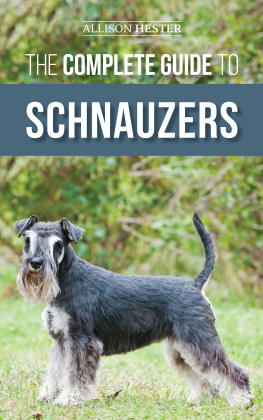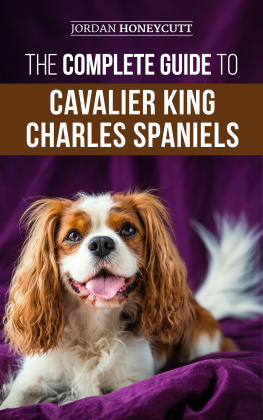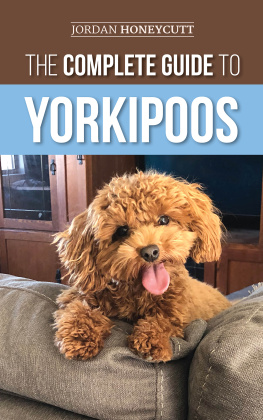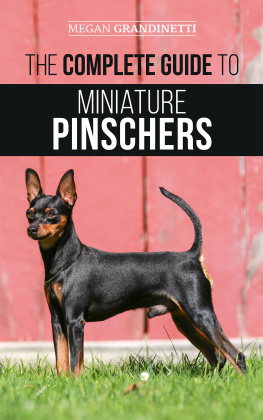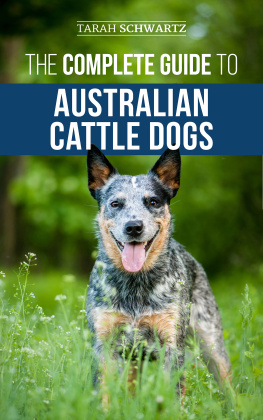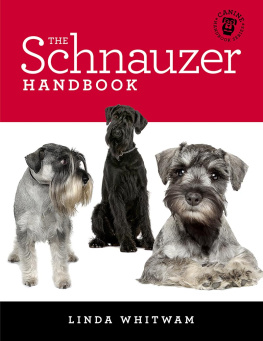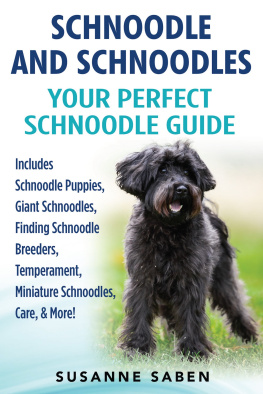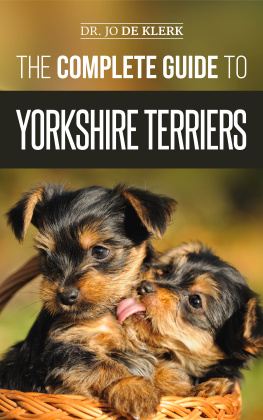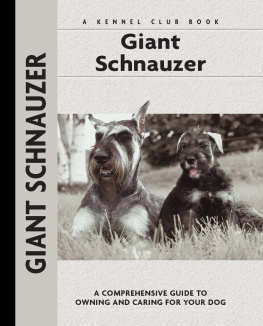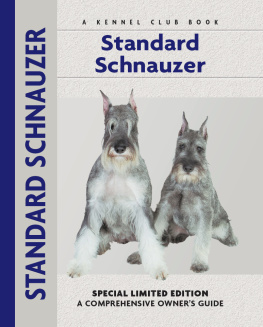Table of Contents
LP M edia Inc. Publishing
Text copyright 2 020 by LP Media Inc.
All rights reserved.
No part of this book may be reproduced or transmitted in any form or by any means, electronic or mechanical, including photocopying, recording, or by an information storage and retrieval system except by a reviewer who may quote brief passages in a review to be printed in a magazine or newspaper without permission in writing from the publisher. For information address LP Media Inc. Publishing, 3178 253rd Ave. NW, Isanti, MN 55040
www.lpmedia.org
Publication Data
Schnauzers
The Complete Guide to Schnauz ers First edition.
Summary: Successfully raising a Schnauzer Dog from puppy to old age Pr ovided by publisher.
ISB N: 978-1-952069-96-3
[1. Schnauzers No n-Fiction] I. Title.
This book has been written with the published intent to provide accurate and authoritative information in regard to the subject matter included. While every reasonable precaution has been taken in preparation of this book the author and publisher expressly disclaim responsibility for any errors, omissions, or adverse effects arising from the use or application of the information contained inside. The techniques and suggestions are to be used at the readers discretion and are not to be considered a substitute for professional veterinary care. If you suspect a medical problem with your dog, consul t your veterinarian.
Desig n by Sorin Rdulescu
First pap erback edition, 2020
The Complete Guide to Schnauzers
Allison Hester
CHAPTER 1
Overview Of The Breed
What is a Schnauzer?
W hen people think of Schnauzers, the image that typically comes to mind is the adorable little silver dog with the charming bushy beard and eyebrows. This seems fitting since in Germanwhere the breed originatedthe word Schnauzer refers to the word snout, and is a popular expression for mustache o r whiskered snout.
Beyond their celebrated looks, Schnauzers also are known for their temperaments. They are considered one of the smartest dog breeds because they are both easy to train and yet still able to think on their feet. They are awesome guard dogs, and extremely loving and loyal to their families.
Ive been the owner of a rescued Miniature Schnauzer for nine years, and its been an amazing experience. I have owned numerous dogs over my almost 50 years of life, but none have been as special to me as my Schnauzer. Funny, sweet, protective, and extremely loyal, she is truly a cherished me mber of our family.
Three Distinct Breeds
While most people think of Schnauzers as the miniature variety, there are actually three distinct breeds of Schnauzers: the Miniature Schnauzer, the Standard Schnauzer, and the Giant Schnauzer. The Standard Schnauzer was the original German version of the dog, and the Miniature and Giant were developed after crossbreeding to create the desired size and characteristics.
The Miniature Schnauzer is an extremely popular dog, once listed as the third most popular breed by the American Kennel Club (AKC). As of the time of writing this book, the Miniature Schnauzer is 17th in popularity. Miniature Schnauzers are members of the terrier group, but they are not actually related. The AKC approves salt and pepper, black and silver, and solid black as acceptable coats. Miniature Schnauzers can also be pure white, but that is not an approved AKC color. Miniatures stand about one foot tall at the shoulder, weigh between 14 and 20 pounds, and typically live around 12 to 15 years.
The Standard Schnauzer was the original version of the breed. These dogs stand around 1.5 feet tall and weigh between 30 to 50 pounds. Their wiry coats are either solid black or salt and pepper. Standard Schnauzers are members of the working dog group and were first bred in Germany to catch vermin and guard properties. They have also been used to carry mail in times of war, to support Red Cross efforts, and as police dogs. Today they are the least popular of the three breeds, rated 85th of 193 in breed popularity by the AKC. Standards typically live between 13 and 16 years.
The Giant Schnauzer is the largest of the Schnauzer breeds, and it is quite the impressive beast. Standing over two feet high at the shoulder, and weighing up to 85 pounds, this muscular breed is a member of the working group. The Giants double coat is either salt and pepper or solid black. These dogs are rated by the AKC as 79th in popularity out of 193 breeds. Giants typically live between 12 and 15 years.
History of the Schnauzer
The original Standard Schnauzers history runs at least as far back as the Middle Ages in Germany. In the early days, dogs very similar to Standard Schnauzers were important assets around homes and farms. Standard Schnauzers were designed to be more than just working dogs. They were also important me mbers of the family.
The early Schnauzers were descendants of other early European guarding and herding breeds. They protected farms from vermin, herded farm animals, and protected both livestock and their families. They could often be found accompanying their family members to market, where they loyally guarded their owners carts.
Early Schnauzer coats came in a variety of colors, including tan, red, black, and parti-colored (i.e., black, white, and tan). Around the mid-1800s, Germans began crossbreeding the Standard Schnauzer with the black German Poodle, as well as the gray Wolfspitz to create the black and salt and pepper coat colors. The Standard Schnauzer was actually called the Wire-Haired Pinscher when first exhibited as a show dog in Germany in 1879, and a standard for the breed was first published in 1880. It wasnt until around 1900 that the breed became universally known as the Schnauzer.
The AKC first recognized the Miniature Schnauzer as a member of the Terrier group in 1926although the dogs had no Terrier in them. The breed grew in worldwide popularity after World War II and has been one of the most p opular breeds since.
Giant Schnauzers came on the scene a little after the Miniatures by crossing the Standard with the black Great Dane and the Bouvier des Flandresto. As their name suggests, Giants were designed basically to be a bigger, hardier version of the Standard, handling many of the same taskshelping farmers in several tasks, guarding property, and helping drive animals to marketbut with a bit more gusto. They originated in the Bavarian Alps as cattle dogs. By the early 1900s, Giant Schnauzers also started having more modern roles such as watchdogs and military dogs during WWI and WWII.
Giant Schnauzers didnt make it to America until around 1930, and they were rarely seen in the US until the 1960s. Today, Giant Schnauzers are often used as police dogs in the US, and as carters (i.e., pulling carts filled with supplies) in other parts of the world.
Physical Characteristics
While the three breeds of Schnauzer vary by height, weight, and color, they all have some simi lar characteristics.
Schnauzers have rectangular, strong heads, with a top-flat skull.
They have small, dark brown eyes that are bright and perceptive,

